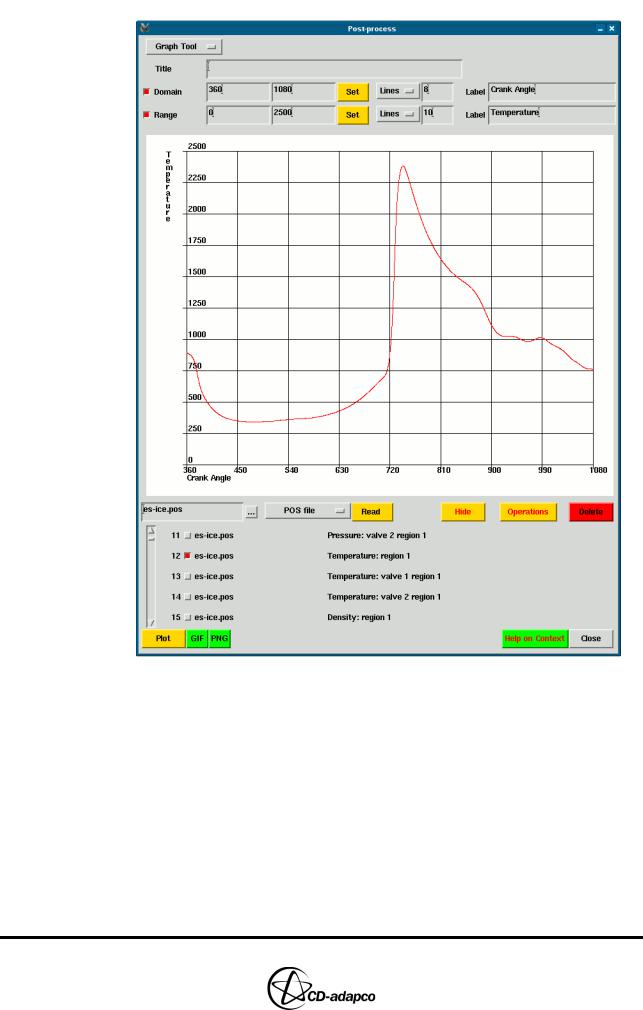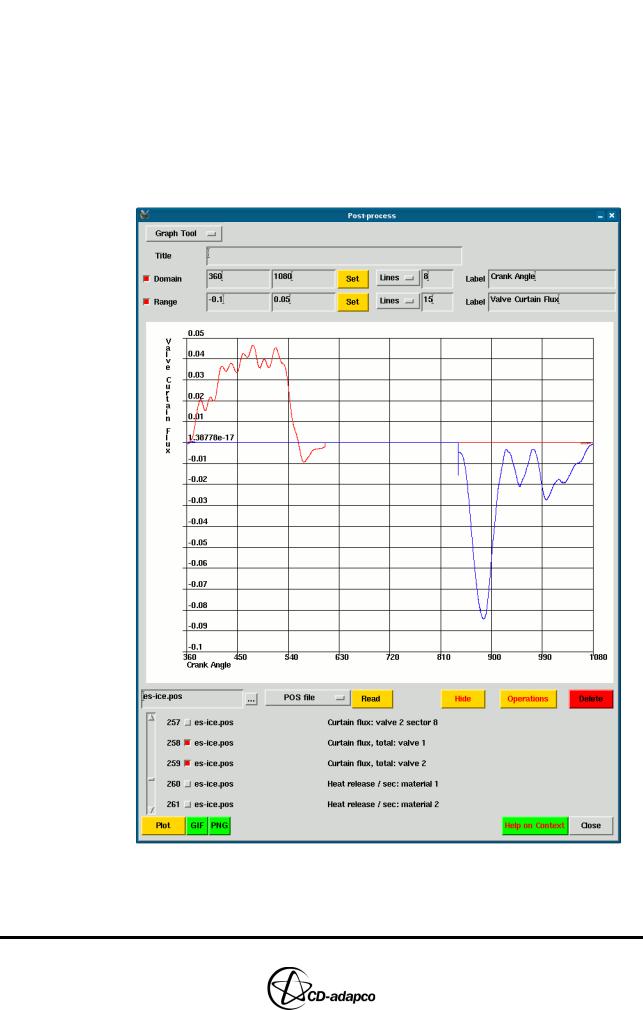
- •TABLE OF CONTENTS
- •Chapter 1 INTRODUCTION
- •The es-ice Environment
- •es-ice Meshing Capabilities
- •Tutorial Structure
- •Trimming Tutorial Overview
- •Required Files
- •Trimming Tutorial files
- •Automatic 2D Tutorial files
- •Wall Temperature Tutorial files
- •Mesh Replacement Tutorial files
- •Multiple Cylinder Tutorial files
- •Closed-Cycle Tutorial files
- •Sector Tutorial files
- •Two-Stroke Tutorial files
- •Mapping Tutorial files
- •ELSA Tutorial files
- •Chapter 2 SURFACE PREPARATION IN STAR-CCM+
- •Importing and Scaling the Geometry
- •Creating Features
- •Defining Surfaces
- •Remeshing and Exporting the Geometry
- •Chapter 3 GEOMETRY IMPORT AND VALVE WORK
- •Importing the Surfaces
- •Modelling the Valves
- •Saving the Model
- •Chapter 4 MESHING WITH THE TRIMMING METHOD
- •Modifying Special Cell Sets in the Geometry
- •Defining Flow Boundaries
- •Creating the 2D Base Template
- •Creating the 3D Template
- •Trimming the 3D Template to the Geometry
- •Improving cell connectivity
- •Assembling the Trimmed Template
- •Running Star Setup
- •Saving the Model
- •Chapter 5 CREATING AND CHECKING THE MESH
- •Chapter 6 STAR SET-UP in es-ice
- •Load Model
- •Analysis Set-up
- •Valve Lifts
- •Assembly
- •Combustion
- •Initialization
- •Cylinder
- •Port 1 and Port 2
- •Boundary Conditions
- •Cylinder
- •Port and Valve 1
- •Port and Valve 2
- •Global settings
- •Post Set-up
- •Cylinder
- •Port 1 and Port 2
- •Global settings
- •Time Step Control
- •Write Data
- •Saving the Model
- •Chapter 7 STAR SET-UP in pro-STAR
- •Using the es-ice Panel
- •Setting Solution and Output Controls
- •File Writing
- •Chapter 8 RUNNING THE STAR SOLVER
- •Running in Serial Mode
- •Running in Parallel Mode
- •Running in Parallel on Multiple Nodes
- •Running in Batch
- •Restarting the Analysis
- •Chapter 9 POST-PROCESSING: GENERAL TECHNIQUES
- •Creating Plots with the es-ice Graph Tool
- •Calculating Apparent Heat Release
- •Plotting an Indicator Diagram
- •Calculating Global Engine Quantities
- •Creating a Velocity Vector Display
- •Creating an Animation of Fuel Concentration
- •Creating an Animation of Temperature Isosurfaces
- •Chapter 10 USING THE AUTOMATIC 2D TEMPLATE
- •Importing the Geometry Surface
- •Defining Special Cell Sets in the Geometry
- •Modelling the Valves
- •Creating the Automatic 2D Template
- •Refining the 2D Template Around the Injector
- •Adding Features to the Automatic 2D Template
- •Using Detailed Automatic 2D Template Parameters
- •Saving the es-ice Model File
- •Chapter 11 MULTIPLE-CYCLE ANALYSIS
- •Setting Up Multiple Cycles in es-ice
- •Setting Up Multiple Cycles in pro-STAR
- •Chapter 12 HEAT TRANSFER ANALYSIS
- •Resuming the es-ice Model File
- •Mapping Wall Temperature
- •Exporting Wall Heat Transfer Data
- •Saving the es-ice Model File
- •Cycle-averaging Wall Heat Transfer Data
- •Post-processing Wall Heat Transfer Data in pro-STAR
- •Plotting average wall boundary temperatures
- •Plotting average heat transfer coefficients
- •Plotting average near-wall gas temperature at Y-plus=100
- •Mapping Heat Transfer Data to an Abaqus Model via STAR-CCM+
- •Chapter 13 MESH REPLACEMENT
- •Preparing the File Structure
- •Rebuilding the Dense Mesh
- •Creating Ahead Files for the Dense Mesh
- •Defining Mesh Replacements
- •Setting Up Mesh Replacement in pro-STAR
- •Setting up the coarse model
- •Setting up the dense model
- •Chapter 14 MULTIPLE CYLINDERS
- •Resuming the es-ice Model File
- •Making, Cutting and Assembling the Template
- •Setting Up Multiple Cylinders
- •Checking the Computational Mesh
- •STAR Set-Up in es-ice
- •Analysis set-up
- •Assembly
- •Combustion
- •Initialization
- •Boundary Conditions
- •Post Setup
- •Time Step Control
- •Write Data
- •Saving the es-ice Model File
- •Importing the Geometry
- •Generating the Closed-Cycle Polyhedral Mesh
- •Assigning shells to geometry cell sets
- •Specifying General, Events and Cylinder parameters
- •Creating a spray-optimised mesh zone
- •Importing a user intermediate surface
- •Checking the spray-optimised zone
- •Creating the closed-cycle polyhedral mesh
- •Running Star Setup
- •Creating and checking the computational mesh
- •Saving the Model File
- •Chapter 16 DIESEL ENGINE: SECTOR MODEL
- •Importing the Bowl Geometry
- •Defining the Bowl Shape
- •Defining the Fuel Injector
- •Creating the 2D Template
- •Creating the Sector Mesh
- •Creating and Checking the Mesh
- •Saving the Model
- •Chapter 17 DIESEL ENGINE: STAR SET-UP IN es-ice and pro-STAR
- •STAR Set-up in es-ice
- •Load model
- •Analysis setup
- •Assembly
- •Combustion
- •Initialization
- •Boundary conditions
- •Post setup
- •Time step control
- •Write data
- •Saving the Model File
- •STAR Set-up in pro-STAR
- •Using the es-ice Panel
- •Selecting Lagrangian and Liquid Film Modelling
- •Setting up the Fuel Injection Model
- •Setting up the Liquid Film Model
- •Setting up Analysis Controls
- •Writing the Geometry and Problem Files and Saving the Model
- •Chapter 18 DIESEL ENGINE: POST-PROCESSING
- •Creating a Scatter Plot
- •Creating a Spray Droplet Animation
- •Chapter 19 TWO-STROKE ENGINES
- •Importing the Geometry
- •Meshing with the Trimming Method
- •Assigning shells to geometry cell sets
- •Creating the 2D template
- •Creating the 3D template
- •Trimming the 3D template to the geometry
- •Assembling the trimmed template
- •Running Star Setup
- •Checking the mesh
- •STAR Set-up in es-ice
- •Analysis setup
- •Assembly
- •Combustion
- •Initialization
- •Boundary conditions
- •Post setup
- •Time step control
- •Write data
- •Saving the es-ice Model File
- •Chapter 20 MESHING WITH THE MAPPING METHOD
- •Creating the Stub Surface in the Geometry
- •Creating the 2D Base Template
- •Creating the 3D Template
- •General Notes About Edges and Splines
- •Creating Edges and Splines Near the Valve Seat
- •Creating the Remaining Edges and Splines
- •Creating Patches
- •The Mapping Process
- •Chapter 21 IMPROVING THE MAPPED MESH QUALITY
- •Creating Plastered Cells
- •Chapter 22 PISTON MODELING
- •Meshing the Piston with the Shape Piston Method
- •Chapter 23 ELSA SPRAY MODELLING
- •Importing the Bowl Geometry
- •Defining the Bowl Shape
- •Setting the Events and Cylinder Parameters
- •Creating the Spray Zone
- •Creating the Sector Mesh
- •STAR Set-up in es-ice
- •Load model
- •Analysis setup
- •Assembly
- •Combustion
- •Initialization
- •Boundary Conditions
- •Time step control
- •Write data
- •Saving the Model File
- •STAR Set-up in pro-STAR
- •Using the es-ice panel
- •Activating the Lagrangian model
- •Defining the ELSA scalars
- •Setting up the Lagrangian droplets
- •Defining boundary regions and boundary conditions
- •Setting up analysis controls
- •Adding extended data for the ELSA model
- •Writing the Geometry and Problem Files and Saving the Model

Chapter 9 |
POST-PROCESSING: GENERAL TECHNIQUES |
|
Creating Plots with the es-ice Graph Tool |
Chapter 9 POST-PROCESSING: GENERAL TECHNIQUES
The following tutorial data files are used in this chapter:
es-ice.pos |
|
|
|
star.mdl |
|
(Created in Chapters 7 and 8) |
|
star.evn |
|
||
|
|||
star.ccmg |
|
|
|
star.ccmt |
|
|
|
TRIMMING_TUTORIALS/scalar1.inp
TRIMMING_TUTORIALS/scriptScalar1.sh
TRIMMING_TUTORIALS/isoTemp.inp
TRIMMING_TUTORIALS/scriptIsoTemp.sh
The tutorial in this chapter demonstrates some general post-processing techniques for engine data in both es-ice and pro-STAR.
es-ice can create XY plots from information in either es-ice output data files (es-ice.pos) or external files with data arranged in columns (XYfiles). es-ice can also calculate global engine quantities such as net indicated work, indicated power and indicated mean effective pressure. In addition, it can calculate apparent heat release from pressure data.
pro-STAR can produce two-dimensional and three-dimensional images displaying scalar and vector quantities within the problem geometry. This feature can be used to analyse conditions within the engine cylinder at a given time step. A series of images can also be exported at each time step and then used with third-party software to animate the entire transient analysis results.
The tutorial covers the following topics:
•es-ice:
(a)Creating plots using the es-ice graph tool
(b)Calculating apparent heat release from a pressure plot
(c)Creating a plot displaying pressure against volume (indicator diagram)
(d)Calculating global engine quantities
•pro-STAR:
(a)Creating a two-dimensional display of velocity vectors through the intake valve at maximum valve opening
(b)Creating a three-dimensional animation of fuel distribution within the cylinder over the entire transient solution
(c)Creating a three-dimensional, four-view animation of temperature isosurfaces within the cylinder over the entire transient solution
Examples of post-processing diesel engine models are provided in Chapter 18 of this volume.
Creating Plots with the es-ice Graph Tool
This section details the creation of plots using the es-ice Graph Tool. Two plots are created, one showing temperature against crank angle and the other showing valve curtain flux for both valves. Note that in using an es-ice.pos file, all values are plotted with respect to crank angle.
Version 4.20 |
9-1 |

POST-PROCESSING: GENERAL TECHNIQUES |
Chapter 9 |
Creating Plots with the es-ice Graph Tool |
|
|
|
First, load the output data file (es-ice.pos) into the graph tool, which displays a list of plot data.
•Launch es-ice in the usual manner
•In the Select panel, click Post-process. The Graph Tool is activated by default in the Post-process panel.
•Click the ellipsis (...) button and select es-ice.pos from the file browser
•Click Read
To plot a graph of temperature against crank angle in the es-ice Graph Tool:
•Select item 12 in the list, labelled Temperature: region 1
•Click Plot
Next, modify the data range to suit the expected temperature values, with grid lines and labels added to improve the plot clarity.
•Select the Domain toggle button
•Enter 360 and 1080 in the next two boxes in order to cover an entire engine cycle
•Select Lines, as opposed to Ticks, from the drop-down menu and enter 8 in the adjacent box
•Set Label to Crank Angle
•Select the Range toggle button
•Enter 0 and 2500 in the next two boxes to cover an appropriate data range
•Select Lines (as opposed to Ticks) from the drop-down menu and enter 10 in the adjacent box
•Set Label to Temperature
When complete, the panel will look as shown in Figure 9-1.
9-2 |
Version 4.20 |

Chapter 9 |
POST-PROCESSING: GENERAL TECHNIQUES |
|
Creating Plots with the es-ice Graph Tool |
|
|
Figure 9-1 Temperature against crank angle plot
The Graph Tool can also plot multiple data sets in a single plot. The data set colour can be modified to provide a clear distinction between the sets.
To create a plot of valve curtain flux against crank angle for both valves:
•Deselect the toggle button next to item 12 to clear the temperature data from the graph display
•Select items 258 and 259 in the list, labelled Curtain flux, total: valve 1 and
Curtain flux, total: valve 2, respectively
•Click Plot
•Set the Range to -0.1 and 0.05 to cover a more suitable data range
•Set the number of lines to 15
•Set Label to Valve Curtain Flux
Version 4.20 |
9-3 |

POST-PROCESSING: GENERAL TECHNIQUES |
Chapter 9 |
Creating Plots with the es-ice Graph Tool |
|
|
|
Currently, both data sets are plotted in red. To change the line colour for valve 2:
•Enter the following command in the main es-ice window:
Graph, Format, 259, Color, 4
In this case, 259 defines the data set and 4 changes the colour to blue
•In the Graph Tool, click Plot
When complete, the panel appears as shown in Figure 9-2.
Figure 9-2 Valve curtain flux against crank angle plot for both valves
Plots can also be exported as .gif or .png files by clicking the respective GIF or
9-4 |
Version 4.20 |
